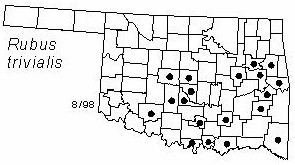Trailing vine which often roots at the nodes. Twigs have reddish glandular hairs; prickles are small and scattered. Leaves alternate, palmately compound, with 3-5 leaflets, variable in size and shape; leaflets elliptic to narrow-ovate, twice as long as broad; glabrous; acute to acuminate at apex; margins serrate to dentate; spiny. Inflorescence a solitary flower on an armed and glandular pedicel; calyx 5-lobed, glandular and reflexed; petals 5, white to pink; pistils many, inserted on hypanthium; stamens numerous; flowers appear from March to April. Fruit an aggregation of drupelets, 6-25 mm (1/4-1 in) in diameter, black; fruits mature June to July.
Distribution: Colorado, east to Missouri and Pennsylvania, south to Florida, west to Louisiana, Texas, and Oklahoma. Common.
Habitat: woodland margins, old-fields.
Comment: Rubus is a Roman name meaning red; trivialis refers to the common occurrence of this plant.
Field identification: Rubus is a complex genus. Species are difficult to identify due to frequent hybridization and introgression.
Horticulture: there are several varieties of dewberry available commercially.
Food uses: fruits are eaten raw or used in jams, jellies, and sauces.
Wildlife benefits: dewberry fruits are eaten by many species of birds and mammals.
NWI status: FACU, FAC.
Distribution in Oklahoma: 
BACK
NEXT
RETURN TO INDEX
Last update: 9/17/99
 Go to Oklahoma Biological Survey Home Page
Go to Oklahoma Biological Survey Home Page
 Disclaimer
Disclaimer